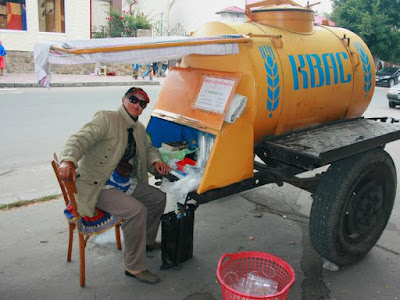10 drinks worth travelling for
 | |
| Holidays and exotic drinks are a match made in heaven
NOTHING says holiday like kicking back with a cocktail or quenching your thirst at a street stall.
There are the obvious ones, like Guinness in Ireland and Cosmopolitan in New York, but some of the most interesting drinks are those you’ve never heard of until you arrive in a new country (and then may swear never to drink again).
Lonely Planet’s latest book, The World’s Best Drinks, lets readers in on the recipes of some of the world’s most famous beverages, as well as some of the lesser known liquid delights that can be found around the globe.
|
 |
| A sidewalk kvas vendor waits for a sale.
SANGRITA
Mexico
Forget the lime and salt: in Mexico, a shot of tequila is traditionally served with a matching glass of this juice combo that’s sweet, sour, spicy — and blood-red. Allegedly, Sangrita was born when thrifty drinkers poured off the juices from a bowl of a Guadalajara-style fruit salad called pico de gallo, seasoned with salt, lime and ground hot piquin chiles. Although Sangrita was little known outside the state of Jalisco until later in the 20th century, it has since spread across most of the country.
Sangrita will help fire up your Mexican adventure.
TEH TARIK
Malaysia & Indonesia
Watching teh tarik being made is a must for visitors to Malaysia and Indonesia
You haven’t arrived in South-East Asia until you’ve drunk a mug of teh tarik — a strongly steeped colonial cuppa served with a generous spoonful of sticky condensed milk. Teh tarik originated with the Mamak (Indian Tamil) community, and Mamak food stalls are still the best place to enjoy the glorious theatre of its preparation. The “pulling” of teh tarik is an art form — anything less than a metre between the two jugs that the tea is poured between would be considered amateur. Virtuoso tea-makers can pour two cups simultaneously, even sideways, while spinning backwards, sloshing the drink from one vessel to the next to achieve the perfect flavour, sweetness and consistency. Miraculously, not a drop is spilt.
YUAN YANG
Hong Kong
Ever wondered what coffee mixed with tea tastes like? The makers of yuan yang did. Picture:
A heady concoction of tea and coffee, with generous lashings of evaporated milk, yuan yang is an invigorating midmorning drink and a bittersweet reminder of Hong Kong’s colonial past.
The beverage is a marriage between South-East Asian coffee and “pantyhose milk tea”, the poor man’s English tea. The latter, served at street stalls and cha chaan tengs (tea cafes), is brewed with eggshells for silkiness, and filtered through a cloth that hangs like a stocking. One day, an operator steeped in Chinese wisdom wondered, “Tea has cool energy — yin; coffee has hot energy — yang. Why not combine the two?” Thus yuan yang was born. It’s doused with creamy calorie-packed milk for the benefit of labourers.
CARIBOU
Quebec, Canada
Caribou is served both chilled and warmed at Quebec’s Winter Carnival.
A popular drink at Quebec City’s Winter Carnival, this boozy Canadian beverage will make you forget all about the cold with its brawny blend of brandy, vodka, sherry, and port. The carnival mocks the frigid weather every February with snow sculptures, parades, parties and other festivities — and of course, the traditional Caribou drink. Caribou can be served chilled or warmed like a mulled wine, spiced with cinnamon. With its mix of booze and fortified wine, this alcoholic punch packs a punch, and warms you up. Many revellers pour their drinks into ‘Bonhomme canes’, hollow canes topped with the head of Bonhomme, the carnival’s snowman mascot. Simply unscrew the head when you want to take a drink!
AYRAN
Turkey
A street vendor sells ayran near Istanbul’s Blue Mosque
TERREMOTO
Chile
Terremoto is like a fruity milkshake ... at first.
The aptly named terremoto (earthquake) is a sweetly potent cocktail made with white wine, a dash of liquor, and — wait for it — pineapple ice cream, served in a large glass. It’s a speciality to seek out at a classic Santiago bar like La Piojera — one of the bars that claims to have invented it — where the waiters carry large trays laden with glasses and the wooden tabletops quickly get sticky with splashes of the creamy concoction. Typically, the terremoto is served with a straw. On the first sip, it’s like drinking a fruity milkshake — then you taste the acidity of the pipeno, a sweet white wine, and the bitterness of the liquor. The first one goes down easy. Finish a second one and the ground might start to feel unsteady.
ANIJSMELK
The Netherlands
Anijsmelk is a Dutch staple.
SIAM SUNRAY
Bangkok, Thailand
The Siam Sunray is a cocktail that really needs to be drunk on location — in Thailand.
source: www.news.com.
|









No comments:
Post a Comment